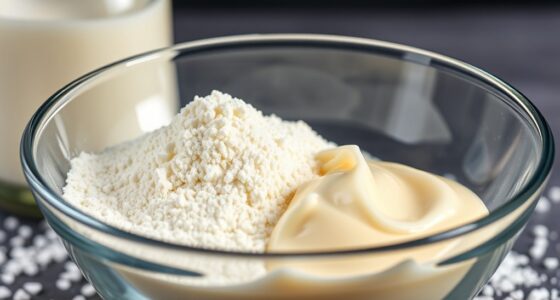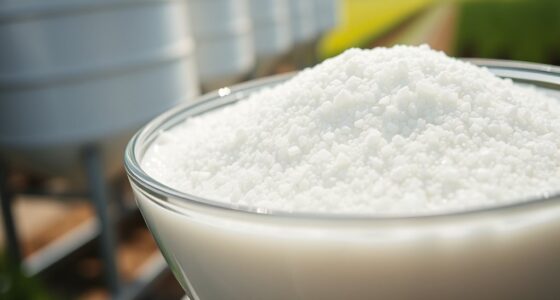Ice cream gets its vibrant colors from natural or artificial dyes. Natural options come from fruits, vegetables, and plants like strawberries, turmeric, and spirulina, offering softer, more authentic hues. Artificial dyes, such as Red 40 and Yellow 5, provide bold, vivid, and neon shades that catch your eye. Whether you prefer subtle or striking colors, understanding these methods helps you make tastier, more informed choices—there’s more to learn about how each type influences what you enjoy.
Key Takeaways
- Natural dyes come from fruits, vegetables, and plants like strawberries, turmeric, and spirulina, offering authentic flavors and softer shades.
- Artificial dyes, such as Red 40 and Blue 1, provide vibrant, consistent, and eye-catching colors for more dramatic ice cream appearances.
- Natural coloring methods are perceived as healthier and more eco-friendly, while artificial dyes are valued for their affordability and stability.
- Natural dyes produce subtle, muted tones resembling real fruit and plant hues, whereas artificial dyes create bold, neon, or pastel shades.
- Consumer preferences vary, with some choosing natural options for health and ethics, and others favoring artificial dyes for vivid and consistent colors.

Have you ever noticed how ice cream colors can instantly evoke different feelings or memories? That vibrant pink strawberry, the bright yellow lemon, or the deep chocolate brown all seem to stir up specific emotions and remind you of particular flavors. But have you ever wondered how these colors get into your favorite treats? It turns out, the answer lies in whether the colors come from natural ingredients or artificial additives. Understanding the difference can help you make more informed choices about what you’re eating.
Ice cream colors come from natural ingredients or artificial additives—know the difference for healthier choices.
Natural ingredients are the original source of many ice cream hues. For example, a strawberry ice cream gets its pinkish-red tone from real strawberries, which contain natural pigments called anthocyanins. Likewise, lemon-flavored ice cream may contain turmeric or other plant-based colorants to achieve its sunny yellow shade, while chocolate ice cream gets its rich brown from cocoa powder. These natural dyes often come with added benefits, as they can contain antioxidants or other nutrients. Plus, they tend to blend seamlessly into the flavor profile, providing a more authentic experience. When you see ingredients like beet juice, spirulina, or turmeric listed on the label, you’re looking at natural ways to color ice cream, often with the bonus of fewer synthetic chemicals.
On the other hand, artificial additives are synthetic dyes created specifically to produce bold, consistent colors. These dyes, like Red 40, Yellow 5, and Blue 1, are manufactured in labs and used widely because they’re inexpensive, stable, and produce eye-catching hues that are difficult to replicate with natural ingredients. They can make pastel pinks, neon greens, or electric blues that instantly grab your attention on store shelves. Some people prefer to avoid artificial additives due to concerns over allergies, hyperactivity, or potential long-term health effects, although regulatory agencies consider many of these dyes safe in moderation. Despite that, the vibrant, unnatural appearance of some ice creams owes much of its appeal to these synthetic dyes.
Ultimately, whether your ice cream gets its color from natural ingredients or artificial additives depends on the brand and your personal preferences. Natural options tend to be more subtle, with softer shades that mirror real fruit and plant hues, while artificial dyes often create more dramatic, vivid tones. Both methods have their place, but being aware of what’s behind the color can help you choose products that align with your values and health priorities. So next time you indulge in a colorful scoop, take a moment to appreciate the science and artistry behind its vibrant appearance.
Frequently Asked Questions
Are Natural Dyes Safer Than Artificial Dyes for Children?
When considering dye safety for children’s health, natural dyes are generally safer than artificial dyes. You should opt for products that use natural ingredients because they’re less likely to cause allergic reactions or other health issues. Artificial dyes may contain chemicals that could harm children over time. So, choosing naturally colored foods and treats helps protect your child’s health and guarantees you’re making safer choices overall.
Do All Ice Cream Flavors Contain Artificial Coloring?
You might think all ice cream flavors are bursting with color, but that’s not always the case. Some rely solely on natural color extraction, while others use artificial dyes for vibrant, stable hues. Not all ice creams contain artificial coloring; many use natural options that aren’t as intense but still appealing. Dye stability is key in maintaining bright colors, especially in commercially produced varieties, making some flavors look more vivid than others.
How Long Do Natural Dyes Last in Ice Cream?
Natural dyes in ice cream typically last about 1 to 2 weeks, but dye stability depends on storage conditions. You might notice that the colors fade or become less vibrant over time, which can impact the visual appeal without affecting flavor. Properly storing your ice cream in an airtight container and keeping it frozen helps maintain the dye’s stability and ensures the flavor remains unaffected by color changes.
Can Natural Dyes Cause Allergic Reactions?
Imagine a delicate butterfly landing gently on your skin—that’s how a dye allergy might feel. Natural dyes can trigger immune responses, causing allergic reactions in some people. If you have a dye allergy, your immune system may overreact to certain natural pigments, leading to symptoms like itching or swelling. Always check ingredient labels and consult your doctor if you suspect a reaction, ensuring your sweet treat doesn’t turn sour.
Are There Regulations on Artificial Dyes in Ice Cream?
You might wonder if regulations limit artificial dyes in ice cream. Yes, regulatory standards set by authorities like the FDA guarantee these dyes are safe for consumption. They also require clear labeling requirements, so you can see if artificial dyes are used. This helps you make informed choices and avoid dyes you might want to steer clear of. Rest assured, these regulations aim to keep your ice cream safe and transparent.
Conclusion
Next time you enjoy a vibrant scoop, remember it’s like a painter’s palette—whether crafted with natural hues or bold artificial dyes, each color tells a story. Imagine a childhood memory of choosing a rainbow cone; that burst of color sparks joy and curiosity. Just like a master artist, food scientists blend ingredients to create these edible masterpieces. So, savor every shade, knowing behind each one lies a colorful journey—natural or synthetic—that makes every bite special.










